
Social Cognition and Executive Function Impairment in Young Women with Anorexia Nervosa
[La cognición social y el daño de la función ejecutiva en mujeres jóvenes que padecen anorexia nerviosa]
Jonathan Adrián Zegarra-Valdiviaa and Brenda Nadia Chino-Vilcaa,b
aUniversidad Nacional de San Agustín de Arequipa, Perú bUniversidad Católica San Pablo, Arequipa, Perú
https://doi.org/10.5093/clysa2018a16
Received 6 May 2018, Accepted 12 July 2018
Abstract
Anorexia nervosa (AN) is a very debilitating disorder and has shown different cognitive deficit patterns. Some of them are controversial because they relate some deficit with autistic traits. Both, social cognition and executive function are top-down processes that regulate social interaction and adaptive behavior in a complex world. Neurocognitive profiles focused on this process are especially useful as endophenotypes in clinic research and intervention.The aims of this study are (1) assessing the contribution of social cognition and executive function to socio-emotional and neurocognitive patterns in anorexia nervosa and (2) investigating the possible relationships between social cognition tasks and executive function measures and clinic features in this eating disorder. Fifteen adolescents with anorexia nervosa and 15 healthy controls took part in this study. Patients were diagnosed with DSM-IV-R criteria. They had suffered the disease for 3 years (SD ± 1.47). They were compared in social cognition (Reading the Mind in the Eyes and the IOWA Gambling Task) and executive function (verbal fluency tasks, trail making test, and digit span test [DST] from the WAIS-III). The results show that there was a significant difference in social cognition, at the theory of mind and the IOWA gambling task. Finally, for the executive function task, adolescents with AN displayed significant differences in both direct DST and inverse DST, as well as in semantic fluency and phonological fluency compared with controls. These domains show different highlysignificant relationships that could explain neurocognitive profiles. In conclusion, many differences were found between adolescents with AN and healthy controls. AN patients displayed important deficits in theory of mind recognition, executive function, and decision making. These deficits could play a role in maintaining pathological patterns and also important endophenotypes in research and intervention might be considered.
Resumen
La anorexia nerviosa es un trastorno muy debilitante y ha mostrado diferentes patrones de déficit cognitivo. Algunos de ellos son controvertidos porque se relacionan con rasgos autistas. Tanto la cognición social como la función ejecutiva son procesos de control “arriba/abajo” que regulan la interacción social y el comportamiento adaptativo en un mundo complejo. Los perfiles neurocognitivos enfocados en este proceso son especialmente útiles como endofenotipos en la investigación clínica y la intervención. Los objetivos de este estudio son: (1) evaluar la contribución de la cognición social y la función ejecutiva a los patrones socioemocionales y neurocognitivos en la anorexia nerviosa y (2) investigar las posibles relaciones entre las tareas de cognición social y las medidas de la función ejecutiva y las características clínicas de este trastorno de la conducta alimentaria. 15 adolescentes con anorexia nerviosa y 15 controles sanos participaron en este estudio. Los pacientes fueron diagnosticados con los criterios DSM-IV-R. Estos han sufrido la enfermedad durante al menos 3 años (SD ± 1,47). Fueron comparados en la cognición social (“Lectura de la mente a través de los ojos” y la tarea de juego IOWA) y función ejecutiva (tareas de fluidez verbal, prueba de seguimiento y prueba de spam digital del WAIS-III). Los resultados muestran diferencias significativas en la cognición social (teoría de la mente y en la tarea de juego de IOWA). Finalmente, para la tarea de la función ejecutiva, los adolescentes con AN mostraron diferencias significativas tanto en la DST directa como en la DST inversa, así como en la fluidez semántica y la fluidez fonológica. Estos dominios muestran diferentes relaciones altamente significativas que podrían explicar los perfiles neurocognitivos. En conclusión, se encontraron diferencias entre adolescentes con AN y controles sanos. Los pacientes mostraron déficits importantes en la teoría del reconocimiento de la mente, función ejecutiva y toma de decisiones. Estos déficits podrían desempeñar un papel en el mantenimiento de los patrones patológicos y también podrían considerarse endofenotipos importantes en la investigación y la intervención.
Palabras clave
Anorexia nerviosa, Endofenotipos, Trastornos de la conducta alimentaria, Función ejecutiva, Cognición social.
Keywords
Anorexia nervosa, Endophenotypes, Eating disorders, Executive function, Social cognition.
Cite this article as: Zegarra-Valdivia, J. A. & Chino-Vilca, B. N. (2018). Social cognition & executive function impairment in young women with anorexia nervosa. Clínica y Salud, 23, 107-113. https://doi.org/10.5093/clysa2018a16
Correspondence: adrianzegarra13@gmail.com (A. Zegarra-Valdivia).
Introduction Anorexia Nervosa (AN) is a complex neuropsychiatric disorder with many interrelations involved in its development and maintenance (Abbate-Daga et al., 2011; Calderoni et al., 2013), such as environmental, familiar, cognitive, emotional, biological, and genetic vulnerability. AN is characterized by fear of gaining weight, inadequate intake, excessive weight loss, and body-image disturbances (American Psychiatric Association, 2013). In the last few years, different studies revealed common traits between the autistic spectrum disorder and AN, associating those symptoms with disruptions in basic neurocognitive processes, especially in social cognition and executive function. These alterations have been proposed as endophenotypes of AN and eating disorders (Hamatani, 2016; Kanakam, Raoult, Collier, & Treasure, 2013). Nevertheless, divergent aspects have been reported, and social cognition studies are in initial stage. Different studies highlight alterations in executive function as key processes involved in etiopathogenesis, focused on the absence of inhibitory control (Claes, Nederkoorn, Vandereycken, Guerrieri, & Vertommen, 2006), cognitive flexibility (Roberts, Tchanturia, & Treasure, 2010), and perseveration (Waller et al., 2012). Additionally, set-shifting has shown to be and important impairment related to chronicity rather than specific endophenotypes (Vall & Wade, 2015); this would be supported by less specific studies, diagnostic specificity, or small groups. Moreover, no specific differences between healthy controls and individuals with AN were found (Vall & Wade, 2015), contrary to other studies (Chan et al., 2013; Lounes, Khan, & Tchanturia, 2011), pointing out a necessity of further analysis. Impulsivity and decision-making have also been surveyed, being affected in AN patients. For example, they exhibit insensitivity to feedback in early stages of the IGT (Aloi et al., 2015), both restrictive and purgative AN, where decision-making looks like an interesting endophenotype of eating disorders (Guillaume et al., 2015; Tchanturia et al., 2007). This poor response reflects an alteration of ventromedial prefrontal structures, what leads to taking more risky decisions. On the other hand, clinical perfectionism has recently become an important trait, relevant in eating psychopathology, where a high level of perfectionism interfere with positive outcomes and the maintaining of AN (Hurst & Zimmer-Gembeck, 2015). This tendency to hold irrational expectations of others and oneself (Flett, Hewitt, Blankstein, & Koledin, 1991) may be supported by failures of the theory of mind, a key process to understanding others’ mind, emotions, and intentions (Baron-Cohen, Leslie, & Frith, 1985). Thus, some studies speculate about the relation of anorexia nervosa and autistic traits (Courty et al., 2013), underscoring deficits in empathic traits (Baron-Cohen et al., 2013) or social cognition skills (Renwick et al., 2015), even when compared with a new variance of Asperger’s syndrome (Oldershaw et al., 2011). Specific deficits in neurocognitive processes such as the theory of mind, decision-making ,and executive function would point out endophenotype related-deficits for psychiatric disorders more than categorical relations. Highlighting neurocognitive networks as endophenotypes would elucidate genetic and neurobiological architecture deficits of the social brain. In summary, social cognition studies suggest an impairment in AN, but are still unclear or contradictory. Likewise, decision-making and executive function (EF) evidence have not been consistently studied in AN. Therefore, the aims of this study are (1) to assess the contribution of social cognition and executive function to socio-emotional and cognitive patterns in AN and (2) to investigate the possible relationships between social cognition tasks and EF measures and clinic features in AN. MethodParticipants All participants were native Spanish speakers and were tested individually in a quiet room at the hospital. The sequence in which tests were administered were identical for all subjects. The demographic and clinical features of the sample are shown in Table 1. Table 1 Demographic and Clinical Characteristics of the Sample 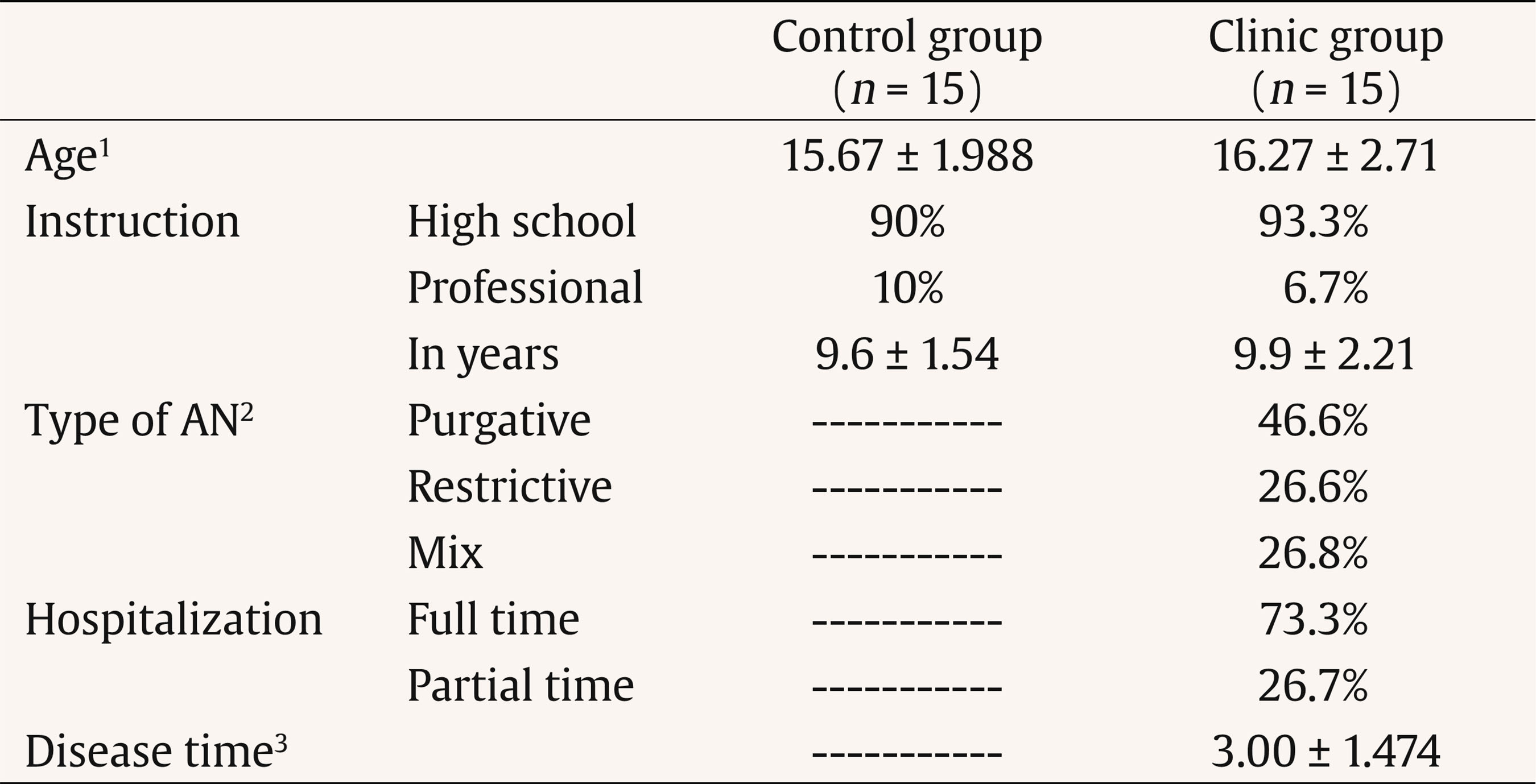 Note. 1Mean and standard deviation; 2by medical history;3from the first clinic diagnosis. Instrument Neuropsychological test. The neurocognitive appraisal was performed in two 30-minute sessions. We used the Reading the Mind in the Eyes (Baron-Cohen, Jolliffe, Mortimore, & Robertson, 1997; Baron-Cohen, Wheelwright, Hill, Raste, & Plumb, 2001) and the IOWA Gambling Task (Bechara, 2004; Brevers, Bechara, Cleeremans, & Noël, 2013; Fukui, Murai, Fukuyama, Hayashi, & Hanakawa, 2005) to asses social cognition. The Reading the Mind in the Eyes is a social sensitivity test (Baron-Cohen, Wheelwright, Hill et al., 2001; Baron-Cohen, Wheelwright, Spong, Scahill, & Lawson, 2001). Participants perceived 36 images of human faces expressing a complex mental state like thoughts, intentions, or emotions through facial expression. Each image was accompanied by four adjectives that described mental state. Participants were asked about the sexual identity of people in the pictures as a control perception task, in conjunction with the appropriate mental state (see Figure 1). Figure 1 Reading the Mind in the Eyes. Chart illustrating the evaluation of gaze and sex recognition. Participants analyze images and choose one mental state out of four possible states. This test measures a person’s ability to understand others’ emotional states. 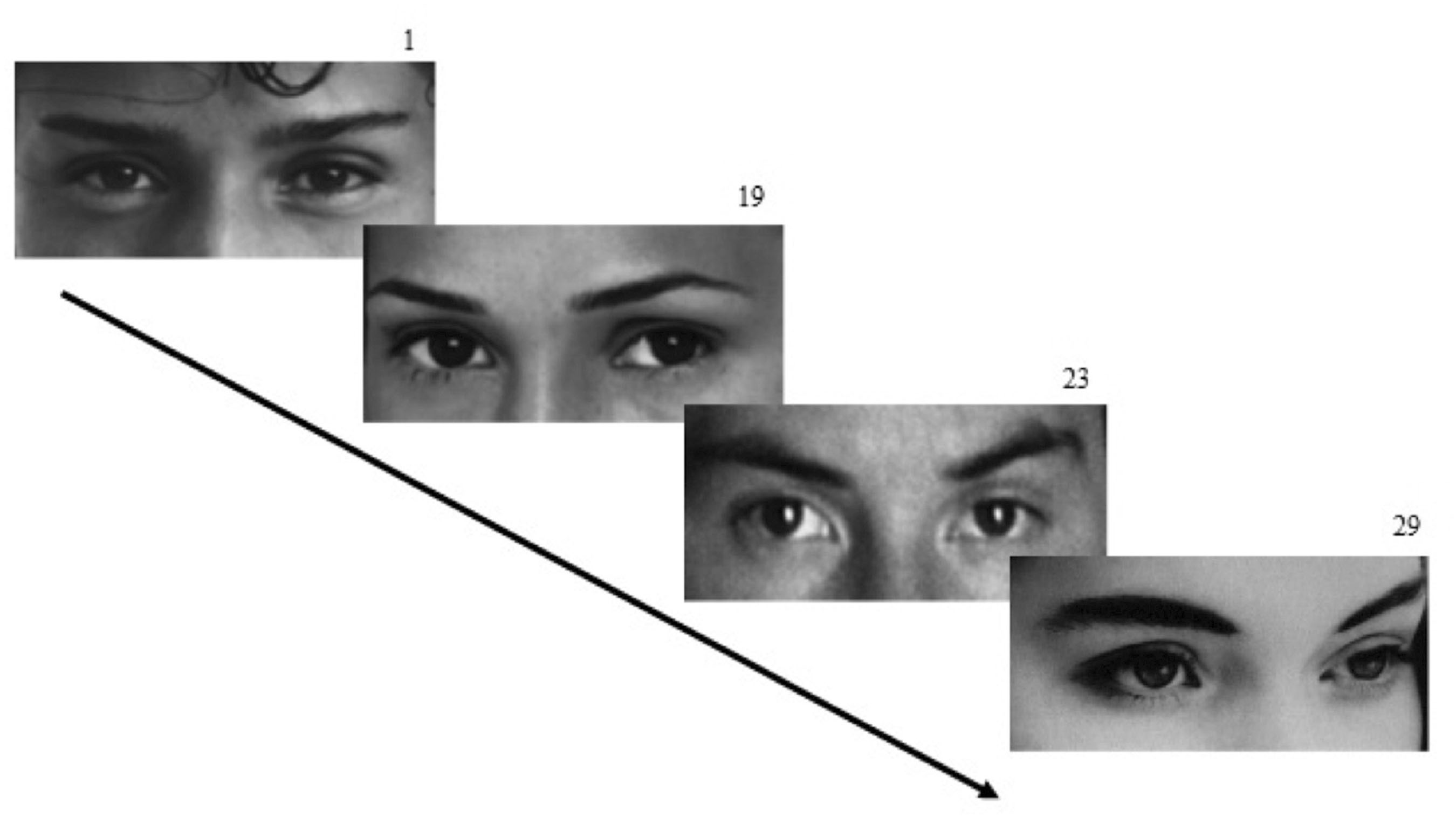 The IOWA Gambling Task was supported by PEBL (Psychology Experimental Building Language; Mueller & Piper, 2014). It measures decision-making by risk-benefit elections following the selection of four possible cards. Participants receive rewards or penalizations in a total of 100 attempts; the assessed subject will know at all times how to make their decisions or not profits, and after 100 attempts the amount of successes/failures that mediated somatic markers (Bechara, 2004) were measured. An emotional learning curve with 5 principal scores of each 20 responses was designed (see Figure 2). The purpose of the game is to obtain the greatest possible reward (León, Martínez, Cruz, & Hernández, 2011). Figure 2 IOWA Gambling Task. A screen shot of the test supported by PEBL. Participants must choose one card by one evoking aleatory rewards or punishment to obtain the major posible cash. A learning emotional curve is given after one hundred attempts.  Other brief neurocognitive tests used to measure executive function were: the verbal fluency test, semantic and phonologic, and the digit span test. Both tests evaluated working memory, flexibility, and attentional shifting (Ardila & Ostrosky, 2012; Tirapu-Ustárroz, Muñoz-Céspedes, Pelegrín-Valero, & Albeniz-Ferreras, 2005; Wechsler, 1997). These tests were selected for its easy and administration and short time of administration. Ethical Statement Neurocognitive appraisal was conducted with the approval of the Research Ethics Board of the “Moisés Heresi” Hospital in accordance with the declaration of Helsinki. Informed consent was obtained from all participants. Data Analysis The statistical analysis was performed with SPSS version 20 (SPSS, Inc., USA). We used the Mann-Whitney U-test to compare both groups. We also used the Spearman correlation between variables. Table 2 displays the Spearman correlations. Results were significant at p < .05 and p < .01. ResultsThe theory of mind and decision-making are core cognitive processes in social cognition. The theory of mind appraisal does not find any difference for recognition of sexual identity (u = 76.000, p < .117) as a control measure of perception process. Gaze recognition of intentions, thoughts, and emotion display statistically significant differences between AN patients and healthy controls (u = 56.000, p < .018) (see Figure 3). The theory of mind is clearly reduced in the clinic group compared with healthy controls and could be related with less social interaction or empathy and more autistic characteristics. The absence of differences in sex recognition display a preserved perception process. More importantly, the mental state essay may show failures to understand others’ mind and will be and indirect measure of their own comprehension of mental states and emotions in these subjects. Figure 3 Reading the Mind in the Eyes. Comparison between clinic and control group. Patients with anorexia nervosa display worse recognition of gaze than controls. Perhaps, they display a normal sex recognition. 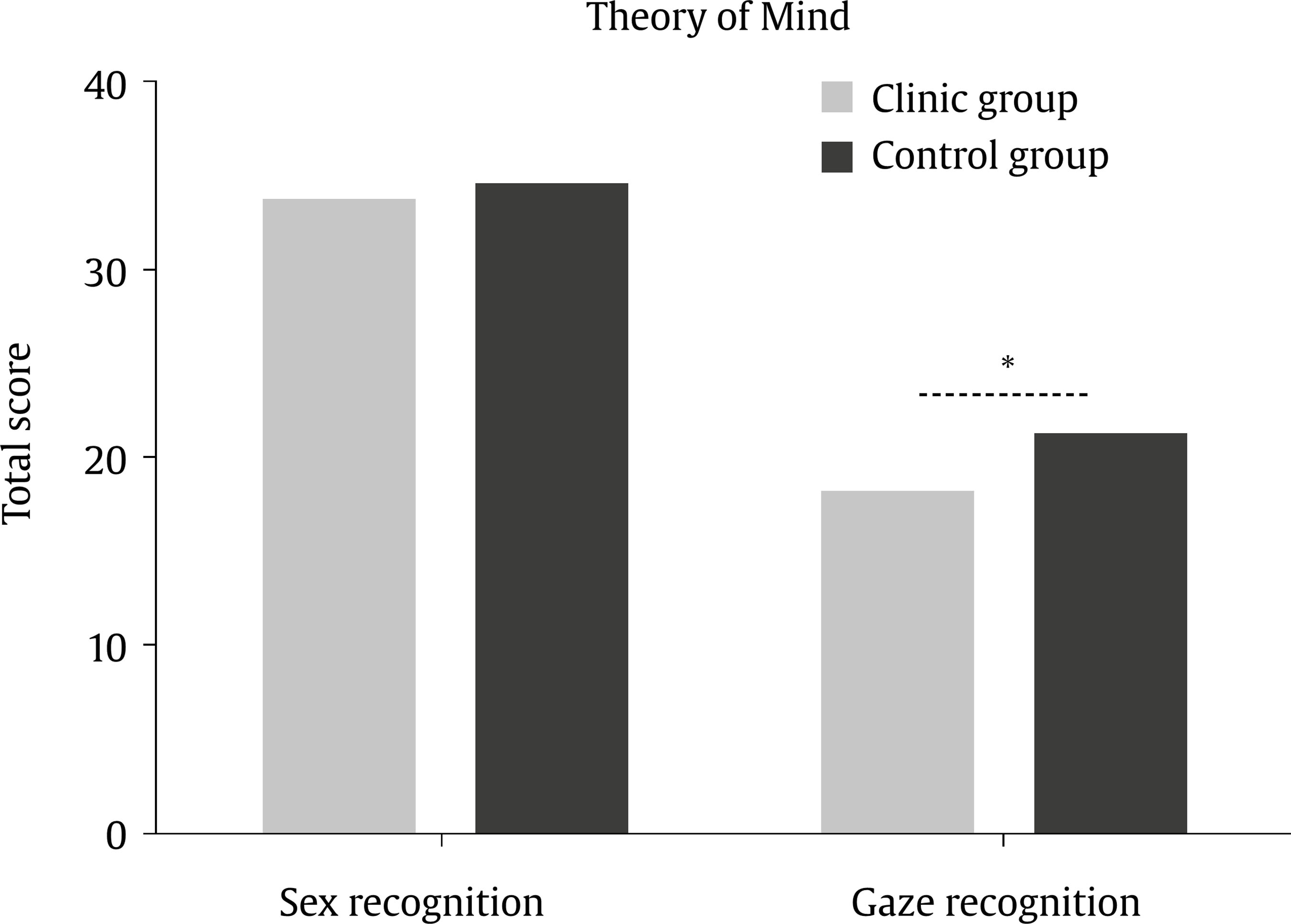 The decision-making essay was divided in five scores (Bechara, 2004): the first one, IOWA 1, obtained with the first 20 items, does not show discrepancy between groups (u = 78.000, p < .150); the second one, IOWA 2 (items 21-40), shows significant differences (u = 63.000, p < .038); IOWA 3 (items 41-60) and IOWA 4 (items 61-80) scores do not display any difference (u = 93.000, p < .411) and (u = 88.000, p < .304) between both groups respectively; the last score, IOWA 5 (items 81-100) exhibits statistically significant differences (u = 47.000, p < .006). Figure 4 displays an emotional-learning curve in this task with five scores. Healthy participants take more advantageous choices over time consistent with feedback across all elections. By contrast, participants with AN take some disadvantageous choices and their feedback does not show an “adaptive” effect on a better selection. Over time, patients are more impulsive, take risky elections, and will be related with poor clinic response. Figure 4 IOWA Gambling Task. The clinic group shows significant differences in IOWA scores 2 and 5 compared with controls. They take more disadvantage decisions showing more impulsivity than controls.  For the executive function (see Figures 5 and 6), direct (u = 58.000, p < .022) and inverse (u = 34.000, p < .001) digit-span test shows significant differences together with verbal fluency, in semantic (u = 52.500, p < .012) and phonologic (u = 63.500, p < .04) tasks. Figure 5 Digit Span Test. The clinic group shows significant differences in both (direct and inverse) task, that displays working memory deficits. 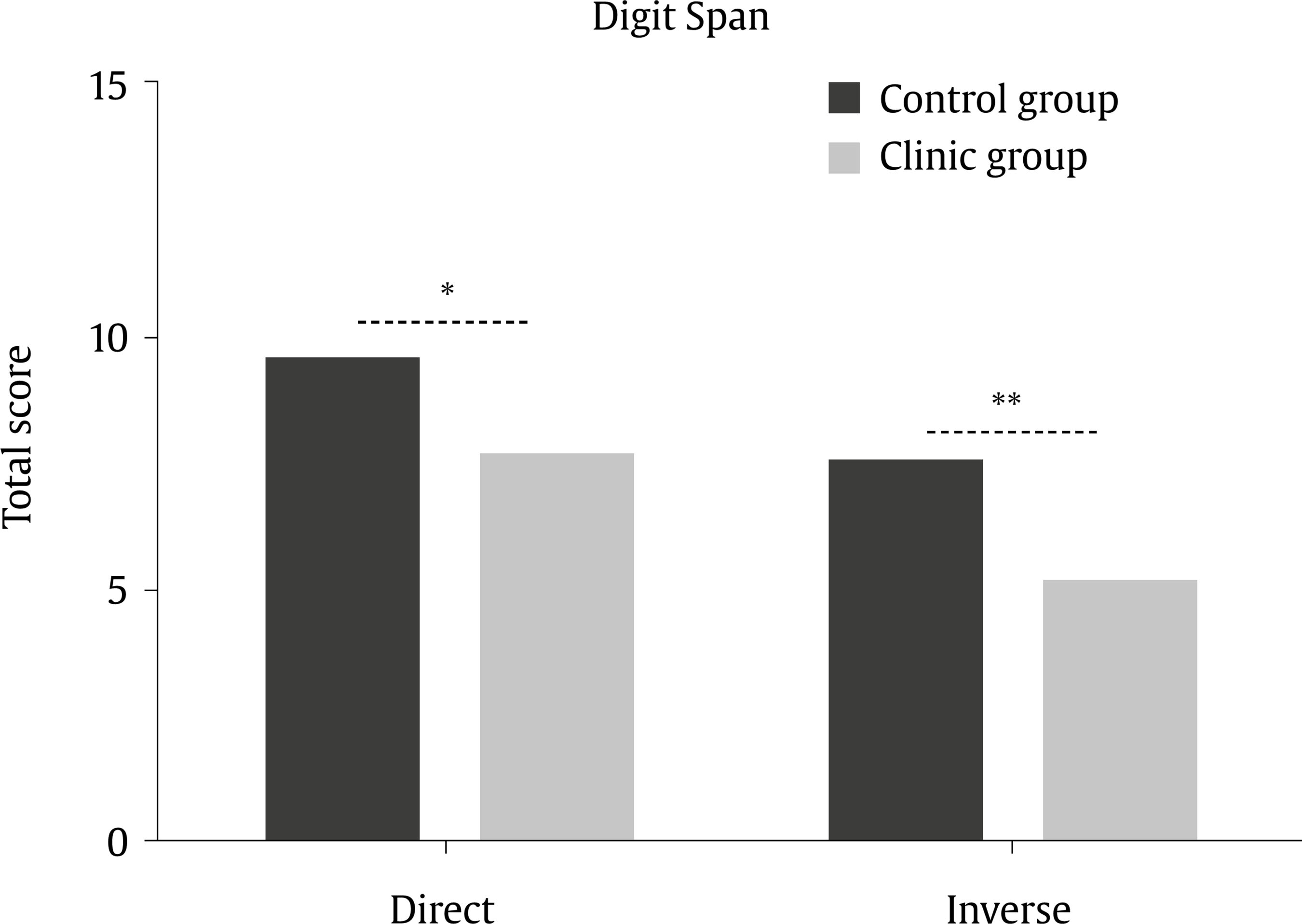 Figure 6 Verbal Fluency. The clinic group shows significant differences in verbal fluency patterns and lexical access with worse semantic and phonological fluency than controls.  Table 2 displays the Spearman correlations. The duration of illness correlate negatively with gaze recognition (p ≤ .033), IOWA 2 (p ≤.006), IOWA 5 (p ≤ .012), and the executive function tasks, such as direct span (p ≤ .015), inverse span (p ≤ .000), phonological (p ≤ .037) and semantic (p ≤ .006) fluency. Other significant relations were not found. Nonetheless, gaze recognition of theory of mind showed positive correlates with inverse span (p ≤ .004) and semantic fluency (p ≤ .022) scores. Table 2 Spearman Correlation 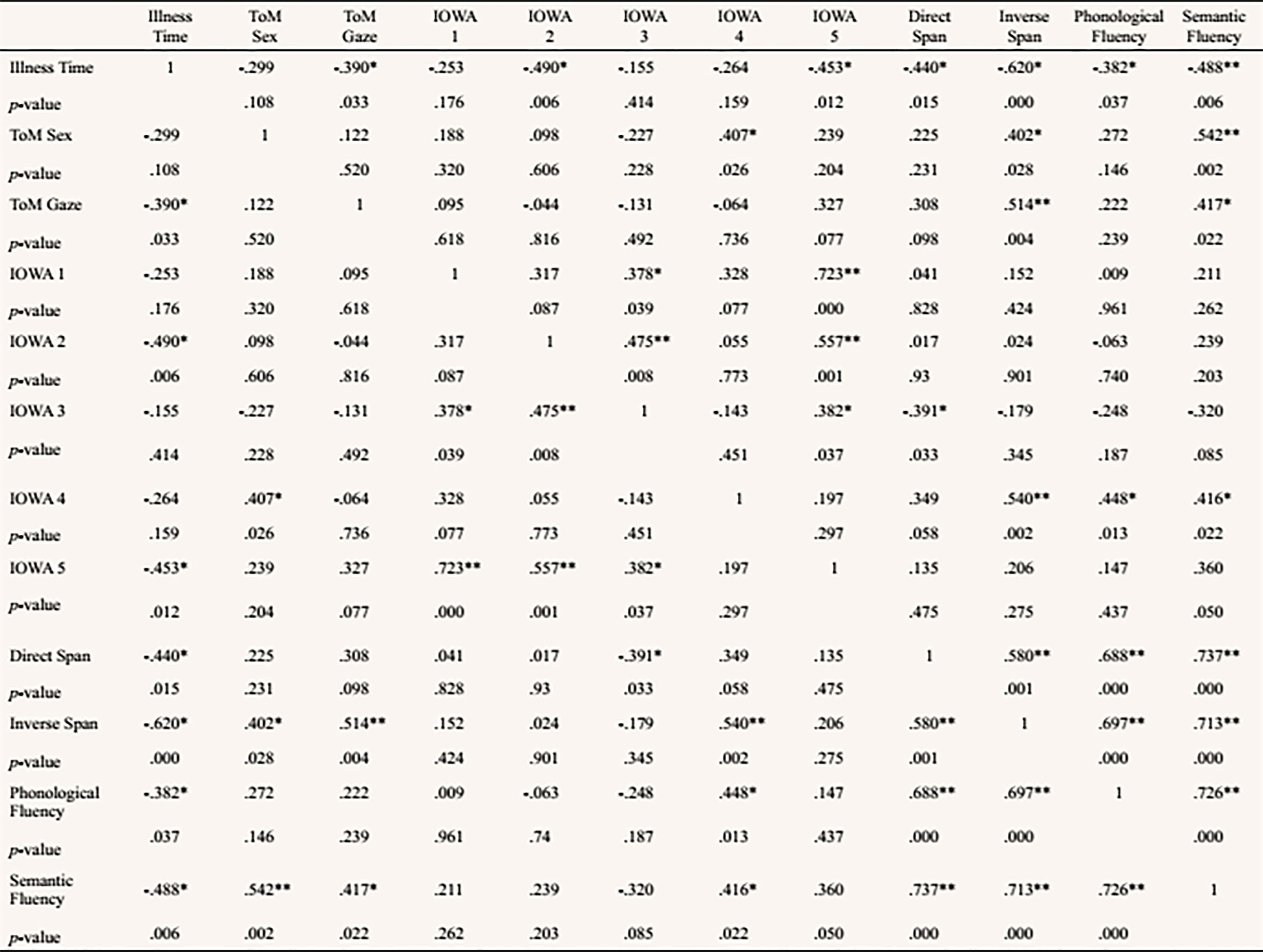 *p < .05, **p ≤ .01. The gambling task shows correlations between scores, as well as digit-span test and verbal fluency (see Table 2). Nonetheless, IOWA 3 correlates with direct span (p ≤ .033*), IOWA 4 with inverse span (p ≤ .002*), phonological fluency (p ≤ .013*) and semantic fluency (p ≤ .022*). Results in the gambling task may reflect a dependent executive function activity (i.e., in more accumulative items in time from 41 to 100 as a working memory mediation). DiscussionThe aim of this study was to evaluate the neuropsychological profile of young people with anorexia nervosa, and compare them with a healthy control group, appraising the social cognition and executive function cognitive processes, and analyzing how they are related. The main result is that young people with anorexia nervosa are characterized by worse social cognition abilities and executive function in comparison with healthy controls. Besides, moderate correlations between domains were found. Those disturbances would be understood as endophenotypes of the disorder. Regarding social cognition, the theory of mind and decision-making were assessed. For the first one, AN shows a normal recognition of sex as a control perceptual task. In contrast, AN patients are less proficient in recognition of intentions, thoughts, and emotions. These results would be related with higher autistic phenotypes (Calderoni et al., 2013; Courty et al., 2013; De Sampaio et al., 2013) showing a poorer analysis of social stimuli, reducing skills to integrate social stimulation and communicative skills, etc. (Kasperek-Zimowska, Zimowski, Biernacka, Kucharska, & Rybakowski, 2016). This process represents a complex control of socio-emotional monitoring, its handicap being that it would be less stable and worse than other disorders such as schizophrenia or the autism spectrum disorder. In a recent meta-analysis study, Westwood et al., (2016) report a significant prevalence of autistic traits in AN patients, although etiology of this deficits is unknown. Further research may clarify if this trait is a feature or a state (Baron-Cohen et al., 2013). For example, studies need to focus on non-affected relatives searching for similar mentalizing patterns, as well as longitudinal studies and more specific selection of participants with the same age, illness duration, and symptoms. In decision-making, our study reflects similar results as previous studies (Guillaume et al., 2015; Tchanturia et al., 2007), that reflect poorer sensitivity to somatic markers and feedback, alteration of ventromedial prefrontal area, and greater need for immediate reward with an alteration of motivational processes involved in decision-making (Bechara, 2004; Damasio, 1994). These patterns seem to be specific of AN and would be important for detailed therapy/rehabilitation (Aloi et al., 2015; Matsumoto et al., 2015). Nonetheless, social cognition might involve a neural system related with consciousness as a cognitive and socio-emotional monitoring explaining different symptoms in AN, and its impairment could be considered as an endophenotype of this disorder. Specifically, in AN, hypoactivation in social-cognitive brain networks was reported, involving temporal and medial prefrontal cortex, orbito-medial prefrontal cortex, and anterior cingulate activity alterations (Oltra-Cucarella, Espert-Tortajada, & Rojo-Moreno, 2012; Schulte-Rüther, Mainz, Fink, Herpertz-Dahlmann, & Konrad, 2012; Tenconi et al., 2015). In the executive function, patients with AN exhibit worse performance compared to healthy controls. Besides, the executive function reflects a complex conjunction of cognitive processes such as verbal fluency, attention, working memory, planning, etc. Our results display similar differences with controls as previous studies (Calderoni et al., 2013; Fagundo et al., 2012; Gillberg et al., 2010; Oltra-Cucarella et al., 2012; Oltra-Cucarella et al., 2015; Zakzanis, Campbell, & Polsinelli, 2010). Alterations in the executive function in anorexia nervosa are well documented, exhibiting profound dysfunctions in prefrontal and cortico-subcortical networks. Other neurobiological correlates involve ventral attention network, fronto-parietal networks, thalamus, caudate nucleus, and putamen (Collantoni et al., 2016; Lao-Kaim et al., 2015; Oltra-Cucarella et al., 2012). As for the relationships between domains, Spearman correlations between the theory of mind and digit span test and semantic verbal fluency are moderate. This would be mediated by some similar mechanisms, as working memory and language, as well as attention networks implicated in both domains (Perner & Lang, 1999). Furthermore, emotion-based decision-making scores correlate with executive function displayed by similar neural mechanisms (Fagundo et al., 2012; Homberg, 2012). On the other hand, illness duration show a negative significant correlation with ToM gaze score, as well as with the executive function test (working memory/verbal fluency), probably indicating an impaired condition of those cognitive processes, regardless of the pharmacological/psychotherapy interventions. The neuropsychological profiles restrict functional and structural processes involved as endophenotypes with neurobiological and genetic disturbances in neuropsychiatric disorders. Given the potential importance of this subject, it is necessary to further investigate the complicated relationship between central coherence, executive function, and social cognition with more specific neurobiological approaches, as fRMI studies, measures of serum neurotrophic factors like BDNF, insulin-like growth factor, oxytocin, vasopressin, leptine, etc. (Dmitrzak-Weglarz et al., 2013; Kasperek-Zimowska et al., 2016; Monteleone & Maj, 2013; Phillips, Jimerson, Pillai, & Wolfe, 2016), or more specific animal models linking biological, behavioral, and cognitive methods. Limitations The main limitation of this study was the small sample size of patients and the absence of AN sub-type groups, such as restrictive or purgative groups. Also a lack of complete neuropsychological evaluation of potential processes, such as central coherence, the cognitive theory of mind, or extending neuropsychological batteries in executive function to evaluate more subdomains, and preferentially with ecological tests (Zoo Test, Wisconsin Card Sorting Test, etc.). Additionally, a follow-up study, and the inclusion of serum measures, sub-clinic, and kin participants would help to understand AN endophenotypes and improve neuropsychological interventions. Acknowledgements The authors would like to thank the participants in this study. Cite this article as: Zegarra-Valdivia, J. A. & Chino-Vilca, B. N. (2018). Social cognition and executive function impairment in young women with anorexia nervosa. Clínica y Salud, 29, 107-113. https://doi.org/10.5093/clysa2018a16 References Ardila, A., & Ostrosky, F. (2012). Guía para el diagnóstico neuropsicológico. Instituto de Neurociencia. Retrieved from http://ineuro.cucba.udg.mx/libros/bv_guia_para_el_diagnostico_neuropsicologico.pdf |
Cite this article as: Zegarra-Valdivia, J. A. & Chino-Vilca, B. N. (2018). Social cognition & executive function impairment in young women with anorexia nervosa. Clínica y Salud, 23, 107-113. https://doi.org/10.5093/clysa2018a16
Correspondence: adrianzegarra13@gmail.com (A. Zegarra-Valdivia).
Copyright © 2026. Colegio Oficial de la Psicología de Madrid








 e-PUB
e-PUB CrossRef
CrossRef JATS
JATS







